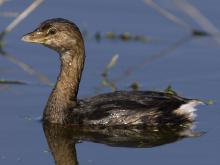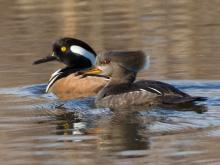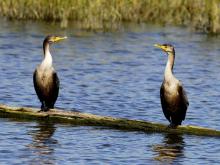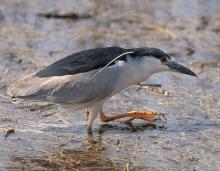Birds
Media

Species Types
Scientific Name
Cathartes aura
Description
The turkey vulture is perhaps the most commonly seen soaring bird in our state. Identify this "buzzard" from below by its shallow V-angled wing posture and two-toned pattern, with the forward edge of the wings black and the trailing half gray or silvery.
Media

Species Types
Scientific Name
Podilymbus podiceps
Description
Small, brown, ducklike birds, pied-billed grebes have thick gray bills with a dark ring around the middle in summer. They dive underwater to forage.
Media

Species Types
Scientific Name
Lophodytes cucullatus
Description
Hooded mergansers have crests that trail behind the head or can be raised to create a circular shape. Their bills are narrow and serrated. Males are black and white with chestnut flanks; females are brown.
Media

Species Types
Scientific Name
Phalacrocorax auritus
Description
Double-crested cormorants are dark, ducklike water birds with long necks, hooked bills, legs set far back on the body, and a habit of hanging their wings out to dry in the sun.
Media

Species Types
Scientific Name
Bonasa umbellus
Description
Restoration efforts are raising the numbers of this chickenlike bird in our state. Look for brown, rufous, and gray streaks, bars, and bands. A dark ruff on the neck appears on both sexes but is used by the male in courtship displays.
Media

Species Types
Scientific Name
Nyctanassa violacea
Description
Adult yellow-crowned night-herons have black heads with creamy white cheek patches and crown. Night-herons are named for their habit of foraging mostly in the evening.
Media

Species Types
Scientific Name
Nycticorax nycticorax
Description
Stocky and short-legged compared to other herons, the black-crowned night-heron has a black crown and back, gray wings, and whitish-gray underparts and head.
Media

Species Types
Scientific Name
Buteo lineatus
Description
The red-shouldered hawk is associated with forests and near water, in places where the lower part of the forest canopy is fairly open. They sit on tree branches and watch for movement on the ground.
Media

Species Types
Scientific Name
Bucephala clangula
Description
The common goldeneye is a common migrant and winter resident in Missouri. A diving duck, it is usually found on open water of rivers and lakes.
Media

Species Types
Scientific Name
Pandion haliaetus
Description
Osprey, also called fish hawks or fish eagles, used to be more common in our state, but their numbers are increasing. Keep an eye out for them, especially around reservoirs and during spring and fall migration, as reintroduction efforts are paying off!
See Also







Media

Species Types
Scientific Name
Hemaris diffinis
Description
The snowberry clearwing is a moth that confuses people because it looks like a bumblebee and flies like a hummingbird!
Media

Species Types
Scientific Name
Hyles lineata
Description
The white-lined sphinx moth sometimes confuses people because it flies, hovers, and eats from flowers like a hummingbird. The adults often fly during daylight hours as well as in the night and are often found at lights.
Media

Species Types
Scientific Name
Darapsa myron
Description
The Virginia creeper sphinx moth is common in woods and brushy areas and comes to lights at night. The larvae eat Virginia creeper and grape leaves.
Media

Species Types
Scientific Name
Perimyotis subflavus (formerly Pipistrellus subflavus)
Description
Tri-colored bats, formerly called eastern pipistrelles, are relatively small and look pale yellowish or pale reddish brown. The main hairs are dark gray at the base, broadly banded with yellowish brown, and tipped with dark brown.
Media

Species Types
Scientific Name
Myotis grisescens
Description
Gray myotises are difficult to distinguish from other mouse-eared bats. A key identifying feature of the gray myotis is that its wing is attached to the ankle and not at the base of the toes. It’s an endangered species.
Media

Species Types
Scientific Name
Myotis lucifugus
Description
The little brown myotis (little brown bat) is one of our most common bats, but populations are declining. White-nose syndrome has taken a heavy toll in northeastern states. This species is now listed as vulnerable across its range.
Media

Species Types
Scientific Name
Myotis sodalis
Description
The Indiana myotis, or Indiana bat, summers along streams and rivers in north Missouri, raising its young under the bark of certain trees. It is an endangered species.
About Birds in Missouri
About 350 species of birds are likely to be seen in Missouri, though nearly 400 have been recorded within our borders. Most people know a bird when they see one — it has feathers, wings, and a bill. Birds are warm-blooded, and most species can fly. Many migrate hundreds or thousands of miles. Birds lay hard-shelled eggs (often in a nest), and the parents care for the young. Many communicate with songs and calls.





















